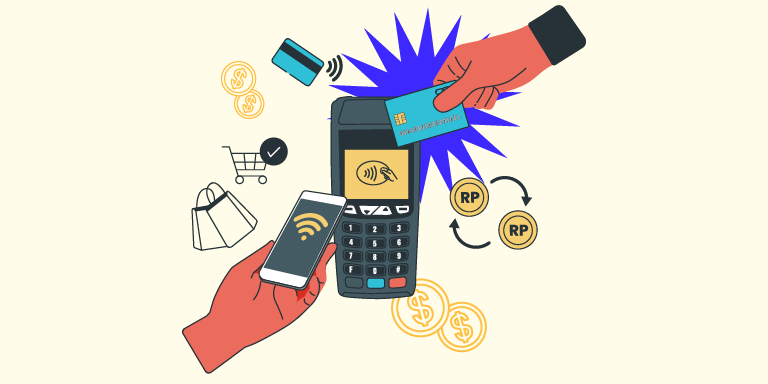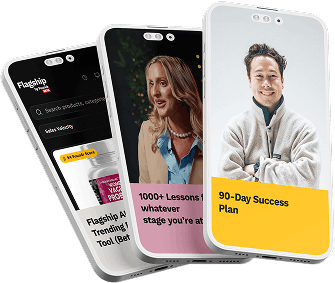Why start a side hustle? Because the “new economy” isn’t just emerging, it is here.
If 2020 taught us anything, it’s that the days of relying on your employer for job security are over.
After Covid-19’s devastating assault on the economy, many people are beginning to realize that relying on a single stream of income as security is so 2019.
Now, it’s all about the side hustle.
While there are many benefits to working a stable job, it can sometimes suck the life out of you. Perhaps you’re not able to pursue your passion or flex your creativity. Maybe you just want to have more impact on the world, and your day job isn’t providing that avenue. Or you simply need a healthier source of income to achieve financial independence.
Whatever the reason, it’s possible to achieve all of this by starting a side hustle that aligns with your skills, interests, passions, and goals.
Why Start a Side Hustle?
- It’s income on your own terms: the economy is too unpredictable to rely on, and a side-hustle can be your plan B if things go sideways
- It’s on the side: You don’t have to give up your day job just yet
- Get paid to do what you love: It can be a great way to make some money on the side while pursuing interests outside of work
- You’re your own boss: You call all the shots and control your own schedule
- It’s scalable: If you decide you enjoy your side hustle more than your job, you can expand it to a full-time business
If the idea of starting a side hustle excites you, but you feel like you don’t have the skillset to get started, we’re here to help! We can almost guarantee that you already possess the abilities needed to start at least one side job.
Here are just 35 of the best side hustle ideas to help identify the perfect way to make a little extra cash.
Here Are the 35 Best Side Hustle Ideas to Get You Started:
Social media copywriter
It’s hard to find a company that isn’t on social media these days. But it’s time-consuming for many brands to prepare multiple social updates each day that increase engagement.
That’s why there’s high demand for social media copywriters who can come up with catchy, on-brand copy for Twitter, LinkedIn, Facebook, and Instagram.
Skills: Familiarity with all the major social media platforms and publishing guidelines
Pricing: $5 – $15 per social media post
Ghostwriter
Executives and thought leaders want to get their ideas out into the world, but they frequently lack the time or ability to write their own articles.
A ghostwriter can take an individual’s voice and opinions on a subject matter and translate it into an article or blog post on their behalf. Keep in mind that it’s ultimately the client’s name that will go on the finished product, not yours.
Skills: The ability to quickly grasp an individual’s unique voice and translate that into writing
Pricing: $300 – $600 per article
Podcast editor or producer
Did you know that podcast listeners are expected to double in the next five years? So now’s the time to level up your podcast editing or producing skills.
If you know how to produce and/or grow a podcast, you could have numerous side business opportunities available to you. If this is something you have prior experience with, brands will be clamoring to work with you.
Skills: Experience with editing and producing podcasts
Pricing: $100 to $400 per episode (editing); $300 to $1,000 per episode (production)
Influencer marketing specialist
If you love partnering with influencers on campaigns and you have a knack for negotiating the perfect product placement photo, then you may be able to offer your skills to brands that are looking for support in this area.
Skills: Experience with influencer marketing campaigns
Pricing: $500 to $2,000 per campaign
Lead generation consultant
If a company’s sales are lagging, it may be a lead generation problem. Your role as a lead generation consultant would be to come in, identify the problem, and offer a strategy to diversify the client’s channels.
Skills: Familiarity with various lead generation channels
Pricing: $100 to $300 per hour
Logo or font designer
Unique branding helps businesses and individuals stand out. If you’re awesome at designing new logos or fonts from scratch, this could be a way to make money on the side.
Clients may either come to you with exactly what they want in mind, or you may serve as a consultant to help them achieve their branding vision.
Skills: Familiarity with design/branding and software platforms like Photoshop or Sketch
Pricing: $100 to $500 per logo or font
READ MORE: 28 Successful Founders Share Their Advice on How To Start a Startup
Browser extension developer
If you have strong web development skills, you can build and sell extensions for common browsers like Google Chrome and Firefox on behalf of your clients. These extensions can add functionality and convenience for users.
Skills: Experience in web development
Pricing: $50 to $200 per hour
Shopify developer
No industry is booming as much as ecommerce these days. And the most popular platform for ecommerce is Shopify, which means there’s a lot of demand for high-quality developers to help people set up and maintain their stores.
Skills: Expertise in working with the Shopify platform
Pricing: $50 to $200 per hour
Data scientist
If you’re a data scientist by training, there are a lot of fun side hustle opportunities available to you.
Many companies are holding onto giant datasets that they don’t have the resources to organize or manage. Step in to help create visualizations or build machine learning models, and make extra money in the process.
Skills: Background in data science
Pricing: $100 to $400 per hour
Quality assurance testing specialist
Nobody wants their code to break. That’s why companies will pay quality assurance testing specialists like yourself to come in and write automated test code or manually test their programs.
Your goal is to ensure nothing in the software breaks and everything works as expected.
Skills: Experience with dev ops and testing best practices
Pricing: $30 to $200+ per hour
Leadership advisor or executive coach
Every leader has strengths and weaknesses. As a coach, use your skills to help executives identify their blind spots and guide them towards improvements via one-on-one sessions.
Skills: Experience with coaching executives
Pricing: $200 to $500 per hour
Public speaking coach
At some point, executives will need to get up and speak in front of a large audience, whether it’s their own employees or at a major conference.
Many leaders will turn to public speaking coaches to help them improve the way they communicate and engage with a crowd or to work on specific issues they may have like stage fright.
Skills: Experience with public speaking or debate
Pricing: $200 to $500 per hour
READ MORE: How to Come Up with a Great Business Name for Your Company
Media trainer
Executives need to be trained before interacting with the media or they risk saying the wrong thing or revealing proprietary information that can create a nightmare for the company.
If you have a background in public relations, build a side hustle coaching leaders on how to successfully navigate interviews with reporters.
Skills: Background in public relations
Pricing: $100 to $500 per hour
Virtual assistant or scheduler
If you have excellent organizational skills, consider a side hustle as a virtual assistant or scheduler!
Your role will entail managing your client’s calendar, and possibly inbox, to keep them on top of their work. The best part is that this is a flexible role you can do from any location.
Skills: A knack for organization and administration
Pricing: $50 to $100 per hour
Project manager
When companies or teams undertake giant projects, they may not have anyone to manage the various moving parts. That’s when a freelance project manager can step in. Your responsibility would be to make sure every aspect of the project moves forward and stays within the outlined parameters (timeline, budget, etc.)
Skills: Experience managing mid-to-large sized projects
Pricing: 1% to 5% of the total project budget
Data entry specialist
With a few basic skills in place, you can easily start a side hustle as a data entry specialist. This role largely entails transferring data from various sources into an electronic database that’s regularly updated and maintained.
Skills: Familiarity working with data on platforms such as Excel, Word, etc.
Pricing: $30 to $60 per hour
READ MORE: The Complete Guide to Getting Clients for Your Consulting Business
Transcriptionist
Are you a speed typer? Then you can make a few extra bucks as a transcriptionist. Clients will hand you an audio recording to convert into written form. You can charge a little extra if you’re providing transcription services in a more complex field like medicine or science.
Skills: Ability to listen, type, and edit
Pricing: $20 to $50 per hour or $1-$2+ per audio minute
Accountant for freelancers
Freelancers have unique accounting needs. Not only are they on a different tax schedule because of the required quarterly payments, but most accountants also don’t have the specialized knowledge to help them with their bookkeeping needs. If you can find a way to use your expertise to serve this growing demographic, you can easily build a side hustle as an accountant.
Skills: Accounting expertise and appropriate licensing
Pricing: $50 to $300 per hour
Financial planner
If you’re a qualified financial professional, use your skills to build a profitable side business. One way is to become a financial planner who helps people plan out their long-term financial goals and strategize ways to meet those goals.
Skills: Financial expertise and appropriate licensing
Pricing: $100 to $300 per hour
Contract writer
Contractual agreements are a necessary aspect of the business. If you have a legal background, specialize in contract writing.
Skills: Legal expertise and appropriate licensing
Pricing: $300 to $1,200 per contract
Virtual tutor
Whether it’s math, science, or English, if you have specialized knowledge in any subject area, you can become a virtual tutor. Simply choose the age group you’re most interested in working with and start looking for clients to help!
Skills: Expertise in the tutoring topic; may require certifications or past experience teaching
Pricing: $30 to $125 per hour
SAT/GRE/GMAT preparation specialist
The results of exams such as the SAT, GRE, or GMAT determine how likely someone is to get accepted into their dream school. If you’ve historically excelled at these tests, and know what it takes to succeed at them, use your abilities to help others achieve their goals.
Skills: Strong test-taking abilities and knowledge of the exam formats
Pricing: $70 to $150 per hour
Translator
Are you a polyglot? If so, you’re in luck! There’s always demand for high-quality translators or interpreters, which means this is an easy way for you to transform your skills into a side hustle. You can decide whether you want to stick to writing, television, or both.
Skills: Mastery of more than one language
Pricing: $60 to $100 per hour
READ MORE: How Much Should I Charge as a Consultant? A Consultation Fee Breakdown
Personal chef
If you love cooking for others, consider a side business as a personal chef. People would hire you to cook meals daily or a few times a week, whether it’s because they want someone to make healthy dinners for them or they don’t have time to cook for their families.
Skills: Cooking abilities; knowledge of food safety
Pricing: $40 to $80+ per hour
Small events caterer
While there are a lot of startup costs needed to launch your own full-blown catering agency, it’s easier and much more cost-effective to start with smaller events as a side business. Eventually, if you love what you’re doing, you can always scale your business into a full-time endeavor.
Skills: Ability to cook for multiple people; knowledge of food safety
Pricing: $30 to $60 per person
Dog walker
People who work 9-to-5 jobs and don’t have pet-friendly offices are always in desperate need of reliable dog walkers. If you have a more flexible schedule and you have time to pop over to a client’s house to give their pup some exercise, dog walking may be an easy way to earn money on the side.
While you can work through existing dog-walking apps, you may be able to find more clients and charge higher prices by striking out on your own.
Skills: Experience with handling dogs
Pricing: $20 to $50 per 30-minute walk
Traveling pet sitter or boarder
Some pet owners don’t feel comfortable leaving their dogs or cats in a strange facility. That’s where traveling pet sitters or boarders save the day.
If you’re comfortable staying in someone else’s home or you have the ability to make multiple visits to feed, walk, and play with your client’s pet, you can easily make a profit as a traveling pet sitter or boarder.
Skills: Comfort with taking care of other people’s pets
Pricing: $40 to $100 per day
Pet party planner
Yes, people celebrate their pets’ birthdays! If you love this idea, consider being a pet party planner as a side hustle. You would be responsible for the planning and execution of a fun event for your client’s pet and its furry friends.
Skills: Experience with event planning
Pricing: $500 to $1,000+ per event (depending on the scope)
Group fitness instructor
If you prefer working with multiple people, consider being a group fitness instructor. Work through fitness boutiques such as Orange Theory, 12RND Fitness, and Barry’s Bootcamp, or find a space to host your own training sessions.
Skills: Proper group training certification, if needed
Pricing: $25 to $70 per hour
Personal stylist or shopper
Some people don’t have the time to do their own shopping or they find it to be an overwhelming experience. If you have a knack for styling, help others by coaching them on their wardrobe or shopping on their behalf. Your goal is to align with the client’s personal style and stay within their stated budget.
Skills: Knowledge of fashion trends; a good eye for design
Pricing: $50 to $150 per hour
Clothing or accessory designer
If you spend most of your free time crafting jewelry or sewing cloth handbags, consider turning this hobby into a side business. People love owning unique, handmade items and would more than likely be willing to pay for your creations.
Skills: Ability to sew, make jewelry, or any other skills necessary to create clothes and accessories
Pricing: $10 to $100+ (depending on the type of clothing or accessory)
Professional organizer or decluttering expert
Everyone dreams of having an immaculately clean and organized home, but most people don’t have the bandwidth or the skills to do so effectively.
If Marie Kondo is your personal hero and you love the process of tidying up, consider turning this passion into a side hustle.
Skills: Knack for organization
Pricing: $80 to $140 per hour
Packing and unpacking services
One of the worst aspects of moving is the tedious process of packing and unpacking all your items. But there are some people who enjoy this and the challenge that comes along with it. If this sounds like you, consider starting a side hustle as a packer and unpacker.
Skills: Experience with packing and unpacking items of all sizes
Pricing: $250 to $1,000+ (depending on size of home)
Technology installer
Love tinkering with the latest home technologies? Offer up your services to neighbors and friends who are having a hard time setting up their Ring security systems, Nest thermostats, or Apple TVs.
Skills: Experience setting up and installing various home technologies
Pricing: $40 to $70 per hour
Birth announcement photographer
Finding out that you’re pregnant is an incredibly meaningful moment for parents. Recently, it has become common for couples to make an “official” birth announcement to share exciting news with their friends and family. These announcements are usually accompanied by fun, creative photos, an awesome side hustle idea for anyone with photography experience.
Skills: Photography
Pricing: $150 to $500 per hour
Did you find this list helpful? It was just a preview! Grab the full list of 100 side hustle ideas by signing up for our Start Your Side Hustle Masterclass – it’s completely free, and will totally change the way you think of starting your own business.
Ready to Start Your Side Hustle?
We’re so excited for you to embark on your side hustle journey! Hopefully, you were able to choose at least a few ideas that resonate with you and you can get started on them soon.
Remember, this side hustle is your business, which means you get to decide how it’s run, from the number of hours you will work to the types of clients you acquire. If you need more support getting your side hustle up and running, sound off in the comments and we’ll lend a hand.


















